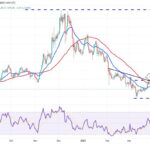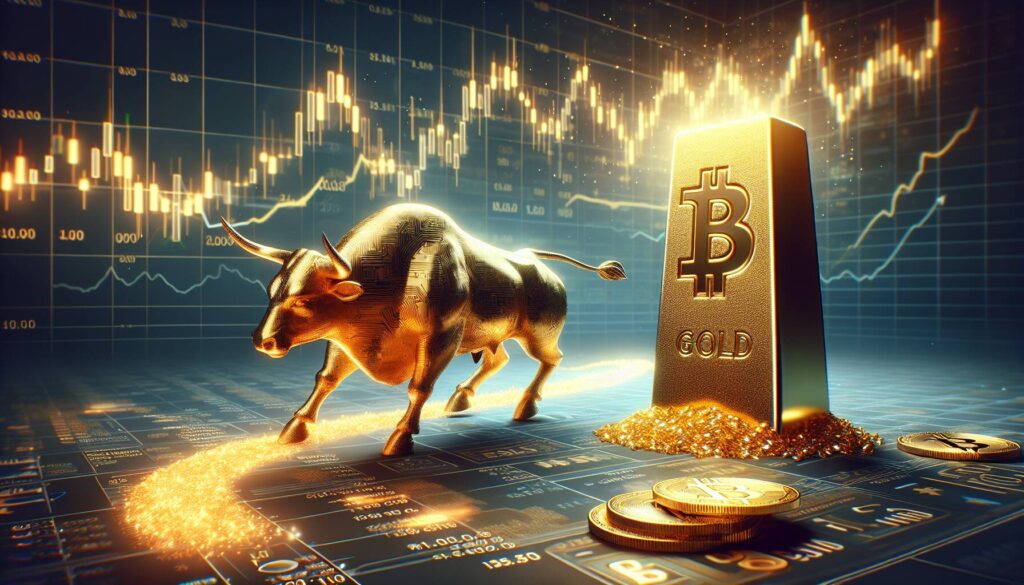As global markets respond to ongoing U.S.-China trade tensions, traditional U.S. assets are facing significant upheaval. Recent data from the University of Michigan reveals a sharp decline in consumer sentiment, dropping to 50.8 from 57.0, the lowest level in nearly three years and below figures recorded during the tumultuous early days of the Covid-19 pandemic. Compounding worries, inflation expectations for the next year surged to 6.7%, marking the highest reading since 1981 and highlighting growing concerns about rising prices.
In light of these economic indicators, investors have begun selling off long-term U.S. government bonds and the U.S. dollar, both of which are typically seen as safe investments during turbulent times. The yield on the 10-year Treasury note soared past 4.55%, climbing more than 50 basis points in just a week, while the dollar index fell below 100, reaching a three-year low. In a curious twist amidst the chaos, gold prices soared to a historic peak of $3,240 per ounce.
Despite the turbulent landscape for traditional assets, cryptocurrency markets are showing resilience and growth. Bitcoin (BTC) has climbed to just above $82,000, reflecting a 4% increase over the past 24 hours, while the broader CoinDesk 20 Index rose by 3%, with notable contributions from altcoins such as Solana’s SOL and Avalanche’s AVAX, each gaining approximately 6%.
“U.S. dollars and U.S. government debt, two of the market’s most liquid safe haven categories, are going haywire,”
observed Noelle Achison, an analyst and writer of the ‘Crypto is Macro Now’ newsletter. This sentiment is echoed by billionaire investor Bill Ackman, who noted that while the recent volatility in Treasury yields raises concerns about the U.S. economic outlook, it may be more indicative of highly leveraged traders being forced out of positions rather than reflecting underlying economic fundamentals. “Technical factors are driving the dramatic market moves,” Ackman remarked, suggesting that the current market conditions may not reliably signal policy changes.

Impacts of U.S.-China Trade Tensions on Financial Markets
As the landscape of traditional U.S. assets fluctuates due to ongoing U.S.-China trade tensions, understanding these changes is vital for consumers and investors alike. Here are the key points to consider:
- Tumbling Consumer Sentiment:
The University of Michigan survey reported a drop in consumer sentiment to 50.8, the lowest level in three years, indicative of growing public concern about the economy.
- Rising Inflation Expectations:
Year-ahead inflation expectations have surged to 6.7%, the highest since 1981, causing anxiety among consumers and investors about future purchasing power.
- Volatile Government Bonds:
Investors resumed selling long-term U.S. government bonds, leading to a significant increase in the 10-year Treasury yield, which soared above 4.55% in just a week.
- Declining Dollar Value:
The dollar index (DXY) fell below 100, reaching a three-year low, which could impact international purchasing power and import costs for consumers.
- Record Gold Prices:
Gold prices reached a record high of $3,240 per ounce, reflecting a shift towards alternative safe-haven assets amid market uncertainty.
- Stock Market Fluctuations:
U.S. stocks remained within a tighter trading range, indicating volatility but also potential buying opportunities for investors focusing on long-term strategies.
- Cryptocurrency Resilience:
Contrary to the decline in traditional assets, cryptocurrency markets have seen gains, with Bitcoin trading above $82,000, suggesting a shift in investor interest.
- Market Reliability Concerns:
Market experts express uncertainty about the reliability of current asset fluctuations, attributing changes more to technical factors rather than underlying economic fundamentals.
“I believe that it is much more likely that recent sharp moves in these asset classes is due to highly leveraged market participants being forced out of positions than due to fundamentals.” – Bill Ackman
Market Turmoil: A Shift in Safe Haven Dynamics Amid U.S.-China Trade Tensions
In the wake of escalating U.S.-China trade tensions, the landscape for traditional assets in the U.S. is under significant stress, creating an intriguing shift in investment behavior. The latest University of Michigan survey indicates a dramatic drop in consumer sentiment alongside surging inflation expectations, which not only reflects a wavering confidence in the U.S. economy but also sets the stage for a broader market reevaluation. The notorious safe havens—U.S. government bonds and the dollar—are experiencing uncharacteristic volatility, raising questions about their reliability during economic uncertainty.
Competitive Advantages: While the U.S. dollar index has fallen to three-year lows, highlighting weaknesses in traditional safe-haven investments, alternative assets like gold and cryptocurrencies are gaining traction. The surge of gold prices to a fresh record of $3,240 per ounce illustrates a persistent investor preference for tangible assets amid inflationary fears. Moreover, cryptocurrencies, particularly Bitcoin, have recently shown resilience and upward momentum, making them appealing alternatives for risk-averse investors seeking to diversify beyond traditional avenues. Investors looking to hedge against the clashing narratives of economic instability may find solace in these assets, especially as they navigate the turbulent waters of the current market.
Disadvantages: However, the volatility observed in U.S. government bonds and the dollar raises concerns regarding their long-term utility as safe investments. Many are questioning whether the U.S. market can provide the reassurances historically expected from these assets. The fluctuation in bond yields, particularly a significant rise above 4.55% in just a week, could signal growing unease among investors, potentially leading to a flight from traditional assets. This environment could create substantial problems for conservative investors unprepared for volatility, leading to significant losses as they pivot away from previously stable investments in search of safer ground.
Ultimately, those who stand to benefit from these tumultuous shifts are more adventurous investors looking to leverage volatility through speculative plays and alternative investments. Conversely, conservative investors holding large positions in government bonds and U.S. dollars may be facing challenges adapting to the rapid changes in market sentiment. As analysts like Noelle Achison and Bill Ackman assert, the movements observed may stem from technical factors exacerbated by leveraged trading, suggesting that the calm of traditional assets might not return elusive time soon.
















